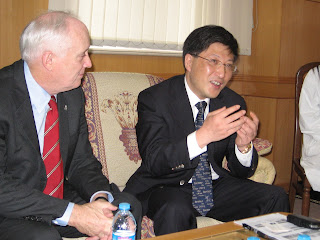 The Grand Facilitator – that is one of the main roles Project HOPE is fulfilling in Haiti today to address the recent cholera outbreak.
The Grand Facilitator – that is one of the main roles Project HOPE is fulfilling in Haiti today to address the recent cholera outbreak.In addition to providing medical volunteers, as well as donated medicines and medical supplies, to care for those now suffering from cholera and to assist in the prevention of the disease, Project HOPE is bringing a team of the world’s foremost experts in cholera to Haiti.
Project HOPE, with the assistance of HOPE volunteer and Massachusetts General Hospital physician Larry Ronan, is coordinating the participation of the International Center of Diarrhoeal Disease Research, Bangladesh (ICDDR,B) to assess the current situation and provide its clinical expertise to enhance the care of cholera patients.
 The eight-person ICDDR,B team, under the direction of Dr. Alejandro Cravioto, is bringing decades of experience in the treatment of cholera and dysentery, as well as the management of major epidemic outbreaks. The ICDDR,B has assisted governments and local health authorities in countries such as Bahrain, Ecuador, Iraq, Mozambique, Peru, Zaire, Nepal, Papua New Guinea and Zimbabwe, in successfully handling cholera outbreaks.
The eight-person ICDDR,B team, under the direction of Dr. Alejandro Cravioto, is bringing decades of experience in the treatment of cholera and dysentery, as well as the management of major epidemic outbreaks. The ICDDR,B has assisted governments and local health authorities in countries such as Bahrain, Ecuador, Iraq, Mozambique, Peru, Zaire, Nepal, Papua New Guinea and Zimbabwe, in successfully handling cholera outbreaks.In addition to the ICDDR,B team, Project HOPE is facilitating the involvement of a four-person team from the United States Agency for International Development (USAID) with the ICDDR,B to help in the creation of a plan to slow and eventually stop the cholera outbreak.
 Project HOPE has facilitated all of these resources, in addition to a volunteer team of physicians and nurses from the Massachusetts General Hospital and the delivery of nearly $200,000 of medical supplies in less than one week – all the result of 52 years of experience in dealing with natural disasters.
Project HOPE has facilitated all of these resources, in addition to a volunteer team of physicians and nurses from the Massachusetts General Hospital and the delivery of nearly $200,000 of medical supplies in less than one week – all the result of 52 years of experience in dealing with natural disasters.It is these types of resources – global expertise, medical volunteers and medicines and medical supplies – that Project HOPE is bringing to bear to benefit the people of Haiti and others around the world in need of our help.
Learn more about HOPE's response to the cholera outbreak in Haiti.
John
































.jpg)


+to+be+seen+by+medical+staff..JPG)
























